

sean
Federal Remediation Technologies Roundtable. Member agencies of the FRTR are working jointly to make data more widely available on real experiences and lessons learned in selecting and implementing treatment and site characterization technologies to clean up soil and groundwater contamination at hazardous waste sites.

The remediation case study reports describe the performance and cost of technology applications at full-scale and large-scale demonstration projects. FRTR Remediation Case Study Searchable Database — Provides capability to search hundreds of case studies by keywords and categories, including media/matrix, contaminant types, primary and supplemental technology types, specific site names, or location (states). Salary Wizard™- Do you know what you're worth? Natural Parenting. Applied Biochemistry and Biotechnology, Volume 28-29, Number 1. Client-funded bench-scale investigations concerning the likelihood of successfully applying biological remediation to hazardous wastes must be cost-effective, and they usually need only determine if biodegradation is likely to occur on site.
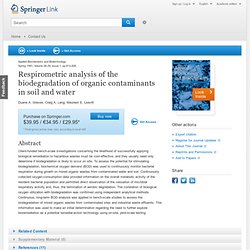
To assess the potential for stimulating biodegradation, biochemical oxygen demand (BOD) was used to continuously monitor bacterial respiration during growth on mixed organic wastes from contaminated water and soil. Environment International : An insight into soil bioremediation through respirometry. Abstract Respirometric tests on a soil contaminated by crude oil were performed.
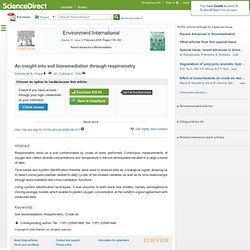
Metagenomics- The Key to Unculturable Microorganisms. Metagenomics is the genomic analysis of microbial communities directly from environmental samples.

While regular microbial genome analysis requires cultivation of the cultures in the lab, metagenomics does not. This type of analysis is initiated by the isolation of DNA from environmental samples. It also generates very useful information about previously unknown genes. Document View - ProQuest. Shallow groundwater in and around Hill Air Force Base (AFB), Utah is contaminated by volatile chlorinated solvents such as PCE and TCE.
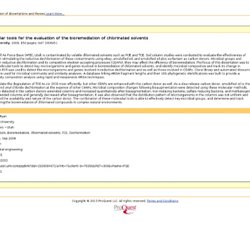
Soil column studies were conducted to evaluate the effectiveness of biostimulation and bioaugmentation in stimulating the reductive dechlorination of these contaminants using whey, emulsified oil, and emulsified oil plus surfactant as carbon donors. Groundwater Remediation. WRHSRC Research Brief #10 - Applying Molecular Techniques to Bioremediation. Applying Molecular Techniques to Bioremediation To solve the strain identification problem, the WRHSRC team has focused on genetic information in Dehalococcoides organisms that encodes for enzymes called reductive dehalogenases.
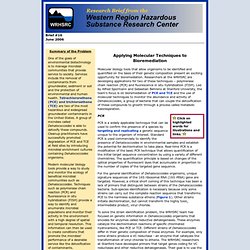
These enzymes catalyze the dechlorination reactions of specific chlorinated hydrocarbons, like PCE or TCE. Different strains of Dehalococcoides differ in their genetic composition of these enzymes. For example, only some strains produce a VC reductase - an enzyme that catalyzes the transformation of vinyl chloride to ethene.
The WRHSRC researchers at Stanford have developed primers that target genes coding for VC reductases and other reductive dehalogenases. The same set of primers can also be used to quantify how the activity of reductive dehalogenase genes changes in response to environmental conditions. Column Experiments The team samples the microbial community by withdrawing material through special ports located along the 30-cm length of the column. Advanced Tools : Past Webinars. Use of Stable Isotope and Molecular Technologies to Enhance Biological Remediation of the Military Explosive RDX Dr.

Eleanor Jennings, Total Environmental Concepts, Inc. introduced by Dr. Brett Baldwin, Microbial Insights July 12, 201312:00 PM - 1:00 PM. DNAPL Source Zones. Chlorinated solvents, such as trichloroethene (TCE) and tetrachloroethene (PCE), are found at an estimated 80 percent of all Superfund sites with groundwater contamination and at more than 3,000 Department of Defense sites in the United States.

These solvents are released into the subsurface as dense nonaqueous phase liquids (DNAPLs), which can persist for centuries. It is both difficult and costly to remediate DNAPLs. Life-cycle costs to remediate these sites could total several billions of dollars. DoD alone could spend more than $100 million every year for hydraulic containment at these sites, using pump-and-treat technologies. Estimates for the military’s life-cycle costs exceed $2 billion. Molecular Biological Tools. Contamination at DoD sites is susceptible to multiple natural and enhanced biological degradation processes.
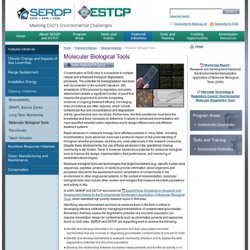
The potential for biodegradation has been well documented in the scientific literature. Still, acceptance of this process by regulatory and public stakeholders entails a significant burden of proof that requires the proponent to provide compelling evidence of ongoing treatment efficacy. Converging lines of evidence are often required, which include contaminant flux and concentrations and degradation activity (geochemical and microbial). Furthermore, the field practitioner must have the knowledge and tools necessary to determine if natural or enhanced bioremediation will meet specified remedial action objectives and to design efficient and cost effective treatment systems. Rapid advances in molecular biology have affected practices in many fields, including bioremediation. Mary Ann Liebert, Inc. - Home. Mary Ann Liebert, Inc. - Home. Mary Ann Liebert, Inc. - Home. A Proteomics Strategy for the Analysis of Bacterial Biodegradation Pathways - OMICS: A Journal of Integrative Biology.
Quantitative proteomic analysis of ibuprofen-degrading Patulibacter sp. strain I11 B.
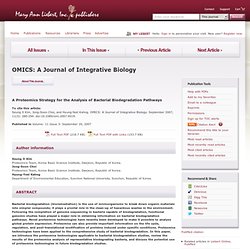
Almeida, H. Kjeldal, I. Lolas, A. D. The potential of metabolomics tools in bioremediat... [OMICS. 2007] - PubMed result. Genomic and mechanistic insights into the biodegra... [Curr Opin Biotechnol. 2004] - PubMed result. A proteomics strategy for the analysis of bacteria... [OMICS. 2007] - PubMed result. Access : Responses of microbial community functional structures to pilot-scale uranium in situ bioremediation : The ISME Journal.
Two Experiments and a Competition « Things we make. I made a fairly ordinary meal last night of sausage and mash, but had a hankering to experiment a bit on the side. Cocktail recipes: 12300+ appetizing drink recipes. Bioremediation. Front Range Mountain Bike Patrol. Executive Summary. Background Groundwater contamination by nonaqueous phase liquids (NAPLs) such as fuels, wood preserving oils, chlorinated solvents, and PCB oils is a common occurrence throughout industrialized areas of North America. NAPLs which are more dense than water are referred to as dense, non-aqueous phase liquids (DNAPLs) while NAPLs less dense than water are referred to as light, non-aqueous phase liquids (LNAPLs).
Although NAPLs exist in the subsurface as a separate liquid phase, they slowly dissolve into flowing groundwater giving rise to aqueous phase plumes. The levels of contamination arising in such plumes is typically far above regulated drinking water standards. The life-span of NAPL in the subsurface is expected to be on the order of several decades to a few centuries depending upon the type of chemicals comprising the NAPL, and site-specific groundwater flow conditions. Kinetic Molecular Theory Notes.